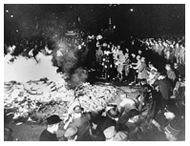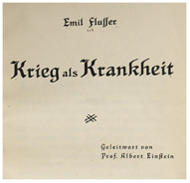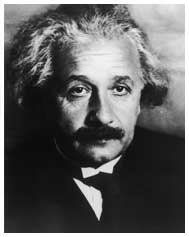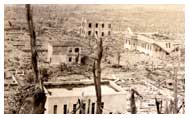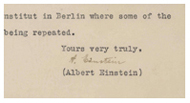"Peace cannot be kept by force; it can only be achieved by understanding."—Albert Einstein, 1955
Scientists and physicians have been at the forefront of international movements for peace. In the early 1930s, Jewish pediatrician Dr. Emil Flusser and Nobel physicist Albert Einstein spoke out against militarism in response to the rise of German Nazism. The tragedy of the Holocaust and the devastation caused by nuclear weapons in World War II convinced many more to work for the future of all the world's citizens.
Dr. Emil Flusser, a pediatrician from Budweis in Southern Bohemia, wrote Krieg als Krankheit (War as Illness). Albert Einstein contributed the book's preface in support of Flusser's argument that war
was a type of mass psychosis. After the book was published in Germany in 1932, copies were burned during Nazi purges of Jewish and pacifist literature and only six copies are known to have survived. Dr. Flusser and his entire
family were killed during the Holocaust. Albert Einstein was able to escape from Germany and went on to help many other refugees fleeing persecution.
Listen to Albert Einstein talking about peace, December 10, 1945
Courtesy National Archives and Records Administration
Read a transcript of Albert Einstein talking about peace, December 10, 1945
The catastrophic impact of nuclear weapons was demonstrated when they were used for the first time during World War II. On August 6, 1945, the American government ordered the atomic bombing of Hiroshima, Japan. Three days later Nagasaki was bombed. Tens of thousands of people were killed instantly, and many survivors were left with terrible injuries.
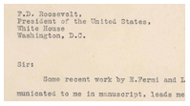 Letter to President Franklin D. Roosevelt signed
by Albert Einstein, 1939
Letter to President Franklin D. Roosevelt signed
by Albert Einstein, 1939Courtesy Franklin D. Roosevelt Presidential Library and Museum
In 1939, former pacifist Albert Einstein signed a letter to President Franklin D. Roosevelt urging him to support research into an atomic bomb. He had fled his home in Germany in the early 1930s in response to the
persecution of the Jews, and was fearful that the Nazi regime would develop nuclear weapons.
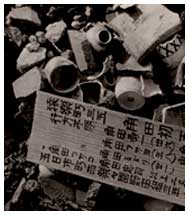 Request for information on missing members of the Kakuta family, Japan, 1945
Request for information on missing members of the Kakuta family, Japan, 1945Courtesy National Library of Medicine
The destruction of hospitals and the devastation of electricity and water supply systems made the difficult task of treating survivors almost impossible. Amidst the chaos, members of the Kakuta family, like many others,
left messages in the rubble asking about missing relatives. The impact of the disaster lasted for years as citizens struggled to rebuild, and continues today as succeeding generations suffer ongoing health problems. Every year,
survivors and their supporters worldwide mark the anniversary with a call for peace.
